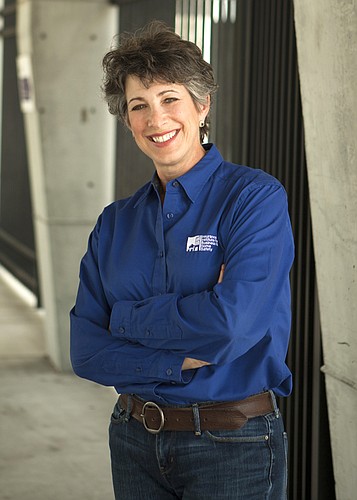Julie Rochman has a paper sign hanging next to her desk with a simple quote: “We will figure it out.” Figuring it out may mean setting a home on fire or creating a hurricane inside a test chamber.
The test chamber is an indoor 2-acre, 70-foot-tall laboratory that replicates natural disasters to provide data for the insurance industry. “Everyone who goes to the lab becomes like a 12-year-old boy,” says Rochman, the 52-year-old president and chief executive officer of the Insurance Institute for Business and Home Safety, commonly called IBHS.
The Tampa-based institute is a nonprofit organization that conducts research to help both sides of the insurance equation: It helps its members — mostly insurance companies — better assess risk, and it helps inform consumers on ways to mitigate theirrisks of property damage. It does this by studying all types of construction best practices, such as how to build or repair residential roofs, as well as disseminating tips, such as how to protect your home from wildfires.
Rochman was hired to IBHS in 2007 to turn the organization around and bring in more scientific data. Historically IBHS relied on compiling information from reports to help insurers. When Rochman joined the team, her one caveat was that they'd bring the testing in house, to ensure there was no bias. “Science has to be at the heart,” she says.
Starting with a team of seven, Rochman has grown the organization to 43 employees with an $11 million budget. The testing facility alone costs $4 million annually to operate.
IBHS represents around 85% of the residential property insurance industry and 60% of the commercial property insurance industry. The organization is funded by membership fees, which are based on exposure to loss, with a rate per millions of dollars of network premiums.
Rochman, a 25-year veteran of the insurance industry, was plucked from Washington, D.C.-based Glover Park Group to head IBHS. She previously worked for the Insurance Institute for Highway Safety, which conducts similar experimentation on crash test dummies.
For the auto insurance industry, you simply have to look up a car's VIN number to determine how it will fare in an accident. Extensive testing of air bags, brakes and other components provides data to help insurers price premiums and evaluate the cause of losses. “On the property side, we're way behind,” Rochman says.
That's why one of her first initiatives was building the $40 million testing facility in South Carolina in 2009. With help from members of her board, especially Farmers Insurance and State Farm, Rochman was able to raise $31 million in a year. IBHS issued $9 million in bonds to cover the rest of the facility. Now she only has around $3.5 million to pay off.
Rochman says the organization's work ultimately benefits the public, though its backbone is reducing losses for the insurance industry. Insurance companies that opt out of membership are missing out on valuable data, she adds.
“Individual companies like what we're doing because they want data, they want to know what works and doesn't work,” to create underwriting factors, rating factors and risk models, Rochman says.
The organization's main focus at this point is damage to roofs. Roofs are the most commonly damaged part of a home or business property, and they are typically repaired by the insurance industry. “We are the largest customer of the roofing industry,” Rochman says. “If we could just get the roofs right in this country, we could probably save half of all insured property losses in a given year.”
So IBHS tests how roofs made of different materials hold up through wind, water, fire and hail. It'll build two-story homes inside the test chamber and replicate Mother Nature to observe the effects. The facility even includes a roof-aging farm, so the organization can test roofs at different stages in their lifecycle.
Then the organization works to inform the public, builders and contractors about the results. It also works with policy makers to try to enforce stricter building codes. Insurance agencies can use the data to incentivize people who are re-roofing to choose one that's stronger.
Rochman loves her job not only because she finds it rewarding that the organization's research is helping people, but also because “it's just a lot of fun.” Borrowing a quote from her Vice President of Research Ann Cope, Rochman says: “If you are the kind of person who likes to build sandcastles and then stomp on them, you'll love working at our lab.”
COMMUNICATIONS FOCUS
Rochman has invested heavily in communications in the last year to promote her organization's findings. When the public is more informed on buying safe and sturdy homes and business properties, it results in fewer losses for the insurance agencies, she says.
Metrics through the first three quarters of 2013:
Website traffic: Up 21%
Facebook: Increased 1.7 million to 11 million, number of engaged (people who share or like content, increased 426% to 357,000
Twitter: Up 35%
Media Exposure: Up 48% hits for national and regional media.






